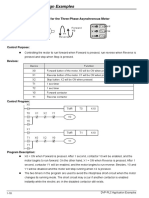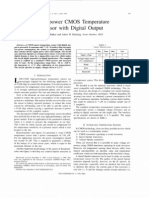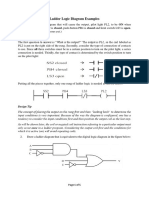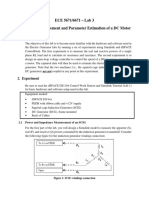ECEg4332 - Assignment
Uploaded by
Yayachew MandefroECEg4332 - Assignment
Uploaded by
Yayachew MandefroUNIVERSITY OF GONDAR
(ATSE FASIL CAMPUS)
ELECTRICAL AND COMPUTER ENGINEERING DEPARTMENT
ECEg5233: INDUSTRIAL AUTOMATION
ASSIGNMENT PROBLEMS
1. Design a PLC program and prepare a typical I/O connection diagram and ladder logic program that will
correctly execute the industrial control process in Figure. The sequence of operation is as follows:
• Product in position (limit switch LS1 contacts close).
• The start button is pressed and the conveyor motor starts to
move the product forward toward
position A (limit switch LS1 contacts open when the actuating
arm returns to its normal position).
• The conveyor moves the product forward to position A and stops
(position detected by 8 off to-on output pulses from the encoder,
which are counted by an up-counter).
• A time delay of 10 s occurs, after which the conveyor starts to
move the product to limit switch LS2 and stops (LS2 contacts
close when the actuating arm is hit by the product)
2. Write a program to implement the box-stacking process illustrated in Figure . This application requires the
control of a conveyor belt that feeds a mechanical stacker. The stacker can stack various numbers of cartons of
ceiling tile onto each pallet (depending on the pallet size and the preset value of the counter). When the required
number of cartons has been stacked, the conveyor is stopped until the loaded pallet is removed and an empty
pallet is placed onto the loading area. A photoelectric sensor will be used to provide count pulses to the counter
after each carton passes by. In addition to a conveyor motor start/stop station, a remote reset button is provided to
allow the operator to reset the system from the forklift after an empty pallet is placed onto the loading area. The
operation of this system can be summarized as follows:
• The conveyor is started by pressing the start button.
• As each box passes the photoelectric sensor, a count is registered.
• When the preset value is reached (in this case 12), the conveyor belt turns off.
• The forklift operator removes the loaded pallet.
• After the empty pallet is in position, the forklift operator presses the remote reset button, which then starts the
whole cycle over again
3. Write a program to operate a light according to the following sequence:
• A momentary pushbutton is pressed to start the sequence.
• The light is switched on and remains on for 2 s.
• The light is then switched off and remains off for 2 s.
Page 1 LAST DATE FOR SUBMISSION : 22/05/2017
UNIVERSITY OF GONDAR
(ATSE FASIL CAMPUS)
ELECTRICAL AND COMPUTER ENGINEERING DEPARTMENT
ECEg5233: INDUSTRIAL AUTOMATION
ASSIGNMENT PROBLEMS
• A counter is incremented by 1 after this sequence.
• The sequence then repeats for a total of 4 counts.
• After the fourth count, the sequence will stop and the counter will be reset to zero.
4. Answer the questions, in sequence, for Figure 9-33 . Assume all switches are turned off after each operation.
Switches S2, S12, and S5 are turned on in order. Will output PL5 be energized? Why?
All switches except S7 are turned off. Will RTO start timing? Why?
Switches S3 and S8 are turned on in order. Will pilot light PL2 come on? Why?
When will timer TON function?
Assume all switches are turned on. In what order will the rungs be scanned?
Assume all switches are turned off. In what order will the rungs be scanned?
Page 2 LAST DATE FOR SUBMISSION : 22/05/2017
UNIVERSITY OF GONDAR
(ATSE FASIL CAMPUS)
ELECTRICAL AND COMPUTER ENGINEERING DEPARTMENT
ECEg5233: INDUSTRIAL AUTOMATION
ASSIGNMENT PROBLEMS
5. Answer each of the following with reference to the counter program shown in Figure
a. Assume the accumulated count of counters C5:0 and C5:1 to be 148 and 36, respectively. State
the value of the number stored in each of the following words at this point:
(1) C5:0.ACC
(2) C5:1.ACC
(3) N7:1
(4) SourceB of the GEQ instruction
b. Will output PL1 be energized at this point? Why?
c. Assume the accumulated count of counters C5:0 and C5:1 to be 250 and 175, respectively. State
the value of the number stored in each of the following words at this point:
(1) C5:0.ACC
(2) C5:1.ACC
Page 3 LAST DATE FOR SUBMISSION : 22/05/2017
UNIVERSITY OF GONDAR
(ATSE FASIL CAMPUS)
ELECTRICAL AND COMPUTER ENGINEERING DEPARTMENT
ECEg5233: INDUSTRIAL AUTOMATION
ASSIGNMENT PROBLEMS
6. Answer each of the following with reference to the overfill alarm program shown in Figure .
Assume that the vessel is filling and has reached the 300-lb point. State the status of each of the
logic rungs (true or false) at this point.
Assume that the vessel is filling and has reached the 480-lb point. State the value of the number
stored in each of the following words at this point:
(1) I:012
(2) N7:1
Assume that the vessel is filled to a weight of 502 lb. State the status of each of the logic rungs
(true or false) for this condition.
Page 4 LAST DATE FOR SUBMISSION : 22/05/2017
UNIVERSITY OF GONDAR
(ATSE FASIL CAMPUS)
ELECTRICAL AND COMPUTER ENGINEERING DEPARTMENT
ECEg5233: INDUSTRIAL AUTOMATION
ASSIGNMENT PROBLEMS
7. Answer the following with reference to the temperature control program shown in Figure
a. Assume that the set-point temperature is 600°F. At what temperature will the electric heaters be turned
on and off?
b. Assume that the set-point temperature is 600°F and the thermocouple input module indicates a
temperature of 590°F. What is the value of the number stored in each of the following words at
this point?
(1) I:012 (2) I:013 (3) N7:0 (4) N7:1 (5) N7:2
c. Assume that the set-point temperature is 600°F and the thermocouple input module indicates a
temperature of 608°F. What is the status (energized or not energized) of each of the following outputs?
(1) PL1 (2) PL2 (3) Heater
Page 5 LAST DATE FOR SUBMISSION : 22/05/2017
UNIVERSITY OF GONDAR
(ATSE FASIL CAMPUS)
ELECTRICAL AND COMPUTER ENGINEERING DEPARTMENT
ECEg5233: INDUSTRIAL AUTOMATION
ASSIGNMENT PROBLEMS
8. Figure shows a materials conveyor system with a flashing pilot light as a subroutine. The operation of the
program can be summarized as follows:
• If the weight on the conveyor exceeds a preset value, the solenoid is de-energized and pilot light PL1will begin
flashing.
• When the weight sensor switch closes, the JSR is activated and directs the processor scan to jump to
the subroutine U:3.
• The subroutine program is scanned and pilot light PL1 begins flashing.
• When the weight sensor switch opens, the processor will no longer scan the subroutine area and pilot light PL1
will return to its normal on state
9. The application is used to indicate a vessel overfill condition. This application requires an alarm to sound
when a supply system leaks 10 lb or more of raw material into the vessel after a preset weight of 500 lb has been
reached. When the start button is pressed, the fill solenoid and filling indicating light are turned on and raw
material is allowed to flow into the vessel. The vessel has its weight monitored continuously by the PLC program
(rung 3) as it fills. When the weight reaches 700 lb, the fill solenoid is de-energized and the flow is cut off. At the
same time, the filling pilot light indicator is turned off and the full pilot light indicator is turned on. Should the
fill solenoid leak 10 lb or more of raw material into the vessel, the alarm will energize and stay energized until
the overflow level is reduced below the 10 lb overflow limit.
10. Develop a ladder diagram for an application which is used as part of a program to convert Celsius temperature
to Fahrenheit and also Kelvin. In this application, the thumbwheel switch connected to the input module indicates
Celsius temperature. The program is designed to convert the recorded Celsius temperature in the data table to
Fahrenheit values for display.
11. Develop a ladder diagram for a motor lock-out program. This program is designed to prevent a machine
operator from starting a motor that has tripped off more than 5 times in an hour. The operation of the program
can be summarized as follows:
• The normally open overload (OL) relay contact momentarily closes each time an overload current is sensed.
• Every time the motor stops due to an overload condition, the motor start circuit is locked out for 5 min.
Page 6 LAST DATE FOR SUBMISSION : 22/05/2017
UNIVERSITY OF GONDAR
(ATSE FASIL CAMPUS)
ELECTRICAL AND COMPUTER ENGINEERING DEPARTMENT
ECEg5233: INDUSTRIAL AUTOMATION
ASSIGNMENT PROBLEMS
• If the motor trips off more than 5 times in an hour, the motor start circuit is permanently locked out and cannot
be started until the reset button is actuated.
• The lock-out pilot light is switched on whenever a permanent lock-out condition exists.
12. Two simultaneous processes are to be performed in two separate tanks which are connected through a valve.
Process 1 takes place in the 1st tank and Process 2 takes in the 2nd tank. Control level of these tanks in PLC
using Ladder Diagram programming language.
Mount two level switches in the first tank and two switches in the second tanks. Both switches of tanks detect
High and Low level of the tanks.
Install inlet valve to control inlet process flow and outlet valve to control outlet process flow.
Install one more connecting valve to control draining of process material from Process 1 Tank to Process 2
Tank.
Provide interlocking to prevent from malfunctioning or overflowing.
13. Design a PLC Program to Control the Sequence of Conveyors and Interlocking Them. A feeder drops material
on the conveyor which sends material for further process through one more conveyor. Conveyor must start
automatically when material is dropped on it. Implement automation of this in PLC using Ladder Diagram
programming language.
Page 7 LAST DATE FOR SUBMISSION : 22/05/2017
UNIVERSITY OF GONDAR
(ATSE FASIL CAMPUS)
ELECTRICAL AND COMPUTER ENGINEERING DEPARTMENT
ECEg5233: INDUSTRIAL AUTOMATION
ASSIGNMENT PROBLEMS
Feeder has a motor mounted to feed material on conveyor belts.
Load cells are installed at the bottom of conveyor belts to detect if material is present on the conveyor belt.
When material falls on conveyor belt 1, motor 1 should start, and when material in present on conveyor belt 2,
motor 2 remain On.
Switches can also be used sometimes to detect material’s presence. But for more reliable operation, Load cells
can be used as shown in the diagram above.
14. This is a PLC Program to Control Mixing in a Tank. Material A and Material B are collected in a tank. These
materials are mixed for a while. Mixed product is then drained out through Outlet valve. Implement this in PLC
using Ladder Logic programming language.
To detect level of Material A and Material B, two separate level switches are used.
Page 8 LAST DATE FOR SUBMISSION : 22/05/2017
UNIVERSITY OF GONDAR
(ATSE FASIL CAMPUS)
ELECTRICAL AND COMPUTER ENGINEERING DEPARTMENT
ECEg5233: INDUSTRIAL AUTOMATION
ASSIGNMENT PROBLEMS
And to detect low level, one more level switch is used at the bottom of the tank.
These give output in digital terms that is when corresponding levels are detected.
To control level of this system, Single Acting Piston valve can be used which has two states, either fully open
or fully close.
To control mixing, agitator is used which is connected with Motor shaft.
Particular time delay is generate to mix the materials for a definite time.
Control inlet valves on the basis of Level Material switches A and B.
Outlet valve is then operated to drain the mixed product.
Instructions:
1. Develop the ladder diagram as per the description.
2. Specify the input and output as table and also mention in Ladder diagram
3. Neatly draw the ladder diagram. Way of Presentation hold the marks
4. Don’t copy the program from others. Those who are trying by their own logic is appreciated.
Page 9 LAST DATE FOR SUBMISSION : 22/05/2017
You might also like
- Large Batching Control Application: Workshop#3: Design of HMI Applications For Process Monitoring100% (3)Large Batching Control Application: Workshop#3: Design of HMI Applications For Process Monitoring6 pages
- PLC Programming Using SIMATIC MANAGER for Beginners: With Basic Concepts of Ladder Logic ProgrammingFrom EverandPLC Programming Using SIMATIC MANAGER for Beginners: With Basic Concepts of Ladder Logic Programming4/5 (1)
- Design of Electrical Circuits using Engineering Software ToolsFrom EverandDesign of Electrical Circuits using Engineering Software ToolsNo ratings yet
- Simulation of Some Power System, Control System and Power Electronics Case Studies Using Matlab and PowerWorld SimulatorFrom EverandSimulation of Some Power System, Control System and Power Electronics Case Studies Using Matlab and PowerWorld SimulatorNo ratings yet
- Creating Relay Logic Diagrams: Lecture #2 Industrial Electronics PME 414100% (1)Creating Relay Logic Diagrams: Lecture #2 Industrial Electronics PME 41416 pages
- Automatic Mixing Controlling in A Tank: Problem DiagramNo ratings yetAutomatic Mixing Controlling in A Tank: Problem Diagram13 pages
- Instant Ebooks Textbook Activities Manual For Programmable Logic Controllers 5th Edition Frank D. Petruzella - Ebook PDF Download All Chapters100% (7)Instant Ebooks Textbook Activities Manual For Programmable Logic Controllers 5th Edition Frank D. Petruzella - Ebook PDF Download All Chapters41 pages
- ETEN4001 SUP PLC Exercises 1 With Solutions100% (2)ETEN4001 SUP PLC Exercises 1 With Solutions5 pages
- FWD Rev Three Phase Motor Using Timer PDFNo ratings yetFWD Rev Three Phase Motor Using Timer PDF1 page
- Chapter 8: PLC Programming Language - Basic InstructionsNo ratings yetChapter 8: PLC Programming Language - Basic Instructions57 pages
- Mastering Siemens S7: A Comprehensive Guide to PLC ProgrammingFrom EverandMastering Siemens S7: A Comprehensive Guide to PLC ProgrammingNo ratings yet
- PLC: Programmable Logic Controller – Arktika.: EXPERIMENTAL PRODUCT BASED ON CPLD.From EverandPLC: Programmable Logic Controller – Arktika.: EXPERIMENTAL PRODUCT BASED ON CPLD.No ratings yet
- SMP Io 2230 Platform Kyz Pulsing Ap912004enNo ratings yetSMP Io 2230 Platform Kyz Pulsing Ap912004en6 pages
- ENGR2105 - Laboratory 3 - Seven Segment LED Stop Clock in Assembly and CNo ratings yetENGR2105 - Laboratory 3 - Seven Segment LED Stop Clock in Assembly and C6 pages
- IEC: Short-Circuit Example 1: ObjectivesNo ratings yetIEC: Short-Circuit Example 1: Objectives10 pages
- PLC Program To Control Level of Two TanksNo ratings yetPLC Program To Control Level of Two Tanks5 pages
- Problem Description: List of Inputs and OutputsNo ratings yetProblem Description: List of Inputs and Outputs2 pages
- Icue H100i H115i H150i H170i Elite Capellix XT Series QSG Ab WWNo ratings yetIcue H100i H115i H150i H170i Elite Capellix XT Series QSG Ab WW122 pages
- Lecture 6 - Industrial Instrumentation and Actuators - 3No ratings yetLecture 6 - Industrial Instrumentation and Actuators - 328 pages
- Customer Churn Prediction Project: Group CNo ratings yetCustomer Churn Prediction Project: Group C16 pages
- Entering The World of GNU Software Radio: Thanh Le and Lanchao LiuNo ratings yetEntering The World of GNU Software Radio: Thanh Le and Lanchao Liu43 pages
- Right TO Privacy: S.S. Jain Subodh Law CollegeNo ratings yetRight TO Privacy: S.S. Jain Subodh Law College15 pages
- Fragmented Contract Management: Challenges, Impacts and SolutionsNo ratings yetFragmented Contract Management: Challenges, Impacts and Solutions22 pages
- Circuits Solutions Sp14 Sp14Week3HomeworkNo ratings yetCircuits Solutions Sp14 Sp14Week3Homework12 pages
- Laboratory Experiment 4 - Configuration of The Local ServerNo ratings yetLaboratory Experiment 4 - Configuration of The Local Server6 pages
- Move and Selection Tools: Polygonal Lasso ToolNo ratings yetMove and Selection Tools: Polygonal Lasso Tool5 pages
- Talend Architecture White Paper - Branded - Final 11302020No ratings yetTalend Architecture White Paper - Branded - Final 1130202018 pages
- Installation Instruction Sheet - 36kV 630A TNo ratings yetInstallation Instruction Sheet - 36kV 630A T8 pages
- Large Batching Control Application: Workshop#3: Design of HMI Applications For Process MonitoringLarge Batching Control Application: Workshop#3: Design of HMI Applications For Process Monitoring
- PLC Programming Using SIMATIC MANAGER for Beginners: With Basic Concepts of Ladder Logic ProgrammingFrom EverandPLC Programming Using SIMATIC MANAGER for Beginners: With Basic Concepts of Ladder Logic Programming
- Design of Electrical Circuits using Engineering Software ToolsFrom EverandDesign of Electrical Circuits using Engineering Software Tools
- Simulation of Some Power System, Control System and Power Electronics Case Studies Using Matlab and PowerWorld SimulatorFrom EverandSimulation of Some Power System, Control System and Power Electronics Case Studies Using Matlab and PowerWorld Simulator
- Creating Relay Logic Diagrams: Lecture #2 Industrial Electronics PME 414Creating Relay Logic Diagrams: Lecture #2 Industrial Electronics PME 414
- Automatic Mixing Controlling in A Tank: Problem DiagramAutomatic Mixing Controlling in A Tank: Problem Diagram
- Instant Ebooks Textbook Activities Manual For Programmable Logic Controllers 5th Edition Frank D. Petruzella - Ebook PDF Download All ChaptersInstant Ebooks Textbook Activities Manual For Programmable Logic Controllers 5th Edition Frank D. Petruzella - Ebook PDF Download All Chapters
- Chapter 8: PLC Programming Language - Basic InstructionsChapter 8: PLC Programming Language - Basic Instructions
- Mastering Siemens S7: A Comprehensive Guide to PLC ProgrammingFrom EverandMastering Siemens S7: A Comprehensive Guide to PLC Programming
- PLC: Programmable Logic Controller – Arktika.: EXPERIMENTAL PRODUCT BASED ON CPLD.From EverandPLC: Programmable Logic Controller – Arktika.: EXPERIMENTAL PRODUCT BASED ON CPLD.
- ENGR2105 - Laboratory 3 - Seven Segment LED Stop Clock in Assembly and CENGR2105 - Laboratory 3 - Seven Segment LED Stop Clock in Assembly and C
- Icue H100i H115i H150i H170i Elite Capellix XT Series QSG Ab WWIcue H100i H115i H150i H170i Elite Capellix XT Series QSG Ab WW
- Lecture 6 - Industrial Instrumentation and Actuators - 3Lecture 6 - Industrial Instrumentation and Actuators - 3
- Entering The World of GNU Software Radio: Thanh Le and Lanchao LiuEntering The World of GNU Software Radio: Thanh Le and Lanchao Liu
- Fragmented Contract Management: Challenges, Impacts and SolutionsFragmented Contract Management: Challenges, Impacts and Solutions
- Laboratory Experiment 4 - Configuration of The Local ServerLaboratory Experiment 4 - Configuration of The Local Server
- Talend Architecture White Paper - Branded - Final 11302020Talend Architecture White Paper - Branded - Final 11302020






























































































